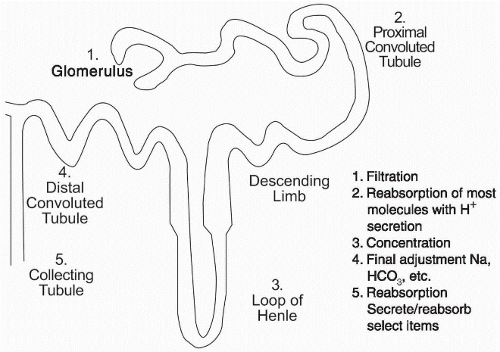Kidney Regulation of Electrolytes and Fluid
QUICK LOOK AT THE CHAPTER AHEAD
The function of the kidneys is to remove and add substances to and from the blood through glomerular filtration, tubular reabsorption, and tubular secretion. These three functions are described here, along with fluid regulation, conservation, and elimination.
Kidneys remove and add substances to and from the blood through glomerular filtration, tubular reabsorption, and tubular secretion. Their ability to reabsorb and secrete electrolytes, maintain an acid-base balance, and conserve or eliminate water is a remarkable system of checks and balances.
Glomerular filtration involves the filtering of fluids and solutes. Protein and blood cells are too large to pass through the glomerular filtration membrane barrier; therefore the filtrate is a protein-free fluid with the same composition as plasma. In the healthy individual this filtrate is isoosmotic at approximately 300 mOsm/L. Approximately 180 L of glomerulate filtrate is formed each day. Of this filtrate, 99% is reabsorbed and 1 to 2 L is considered urine output each day.
The kidneys have the ability to change the acid-base balance or composition of electrolytes in the plasma by changing the composition of
the glomerular filtrate through tubular reabsorption. Active and passive transport are the mechanisms of movement of molecules in the tubules. Some electrolytes passively ride on sodium (cotransport) as it is actively transported through the system. Other ions transport themselves through osmosis or diffusion in passive transport. As solutes become more concentrated on one side of the tubules and the other side becomes less concentrated, fluid flows to the area of increased concentration. This helps to maintain a normal plasma osmolarity.
the glomerular filtrate through tubular reabsorption. Active and passive transport are the mechanisms of movement of molecules in the tubules. Some electrolytes passively ride on sodium (cotransport) as it is actively transported through the system. Other ions transport themselves through osmosis or diffusion in passive transport. As solutes become more concentrated on one side of the tubules and the other side becomes less concentrated, fluid flows to the area of increased concentration. This helps to maintain a normal plasma osmolarity.
Stay updated, free articles. Join our Telegram channel

Full access? Get Clinical Tree



